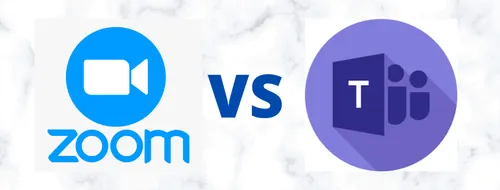
Knowledge base
April 23, 2021
Microsoft Teams Vs Zoom for Work Meetings: Quality and Connection
At a time when most businesses are working from home, meetings have been transferred to various virtual platforms. Microsoft Teams vs Zoom is a popular comparison, and it is one that significantly affects work efficiency. Social distancing has dramatically increased the need for video conferencing, online board meetings, and webinars.
The two main virtual conferencing platforms, Microsoft Teams and Zoom, have become reliable workplace assets as they provide the necessary face-to-face interactions while maintaining physical distance.
Here are the features of both and why you should choose Microsoft Teams over Zoom:
Zoom
Zoom is a virtual video and audio conferencing platform that was founded in 2011. It includes webinar and live chat features that allow up to 500 participants to join at any one time. The meeting setup includes one or more hosts who share the meeting link with the members via SMS or email.
Zoom has a screen sharing feature that allows participants to share files via live chat. It is compatible with all operating systems and participants meet via a web browser or via the Zoom app. The meeting participants are allowed to mute or unmute themselves and the host has the autonomy to mute or unmute any member.
Microsoft Teams
Microsoft Teams is a product in Microsoft 365. This communication platform offers video and audio conferencing options, with a variety of add-ons. It supports online chats, file attachments and file sharing.
The video conferencing feature can accommodate up to 250 participants, while the live streaming option can accommodate up to 10,000 viewers. Microsoft Teams supports screen sharing and allows you to record and save your meetings to DropBox, OneDrive and other digital storage applications. It also allows multiple meeting hosts who may or may not have administrative access. Those with administrator privileges can mute or unmute participants at will.
Here’s how Microsoft Teams vs Zoom stack up:
1. User interface and ease of use
Both platforms allow you to share video calls, voice calls, screens and files. They also have a “virtual rooms” feature that allows you to have multiple meetings within a single conference. With Microsoft Teams you have all the features of Microsoft 365 at your disposal. This gives Teams an edge over Zoom when it comes to functionality.
But the extra features can make the platform complicated to use. You must learn to use all the components of Microsoft 365. This also requires all members of your work meeting to learn as well. That could take a while. Zoom’s user interface is simple for new users. Many learn it in a short time.
2. Features
These two platforms have a striking overlap in features. They both offer video conferencing and dial-in features, file and screen sharing, and live chat features. Both also offer virtual rooms, which are extra small meeting rooms within a large conference. Virtual rooms are great for team building exercises. But Microsoft Teams triumphs over Zoom because of the inclusion of all the additional features of Microsoft 365. Record, save and back up all your meetings with Microsoft 365.
3. Security
When we compare Microsoft Teams vs Zoom for business, security is a top priority. While both claim to take security seriously, Microsoft Teams uses end-to-end encryption, multi-factor authentication, Rights Management Services support, in-transit encryption, and Secure Real-time Transport Protocol technology for audio and video data.
Microsoft provides detailed information about the user data it collects and how it is used. Zoom, on the other hand, uses AES-256 encryption and 256-bit TLS encryption. End-to-end encryption is optional on Zoom. It uses a variety of other security protocols, such as waiting rooms and password-protected meetings.
Zoom has faced significant backlash for misleading and unclear encryption and privacy policies. Recent cases of security breaches have caused it to be banned by several companies and companies. If you’re discussing sensitive information, Microsoft Teams is definitely in place when it comes to security.

4. Technical Support
Zoom offers 24/7 online support for all its plans, including the free version. All paid plans offer phone support, while the Enterprise plan offers a dedicated customer success manager. Microsoft Teams does not include technical support in the free package. However, it offers 24/7 phone and online support for its paid plans.
5. Video Quality
Both Zoom and Microsoft Teams offer HD video resolutions of 1080p at 30 fps. Zoom recommends a minimum connection speed of 3 mbps, while Microsoft Teams uses a minimum of 2 mbps. Zoom’s video quality defaults to 780p, while Microsoft Teams offers 1080p.
6. Pricing
Microsoft Teams offers four packages. One is free and can accommodate up to 300 members and a meeting time of 60 minutes. The other packages are as follows:
- Microsoft 365 Business Basic – offers all the features of the free package plus 1 TB of cloud storage and a maximum meeting time of 24 hours. It costs € 4.20 per month per user.
- Microsoft 365 Business Standard – offers all basic and free features plus Microsoft 365 pack. It costs € 10.50 per month per user.
- Office 365 E3 – offers all the above features plus unlimited cloud storage, advanced security and support. It costs €19.70 per user per month.
In comparison, Zoom has a free package with a limit of 100 people for meetings and 40 minutes per meeting. One-on-one meetings have unlimited access. These are the prices for Zoom:
Pro – allows up to 100 participants with a maximum cloud storage of 1 GB. The meeting time is a maximum of 30 hours and costs € 13.99 per month per user.
business – accommodates up to 300 participants along with all the features offered in the pro package. Additional features include corporate branding, cloud recording transcripts, and managed domains. The costs of this are € 18.99 per month per user.
enterprise – this has all the above features and can accommodate 1000 participants with the Enterprise+. It also has a dedicated customer success manager and costs $18.99 per month per user.
Both Microsoft Teams and Zoom are excellent meeting platforms. However, when it comes to functionality, security and video quality, Microsoft Teams emerges as the better platform. We at Steadfast Solutions can help you set up and get started with Microsoft Teams. Improve collaboration and team building in your company. Contact us today to learn how to get started with Microsoft Teams.
Source: steadfast solutions
Want to know more?

Related
blogs
Tech Updates: Microsoft 365, Azure, Cybersecurity & AI – Weekly in Your Mailbox.









